One evening a fleet manager watched a vehicle on the highway swerve to avoid a stalled car. Her phone pinged with live sensor data, and a cloud alert had already flagged the event. She sighed with relief as remote diagnostics confirmed the fleet avoided a serious incident.
This scene shows how perception, fast decision-making, and actuation come together to keep loads moving. Modern systems combine LiDAR, radar, and cameras with onboard control to reduce human-error crashes. That mix builds trust across an industry under cost and time pressures.
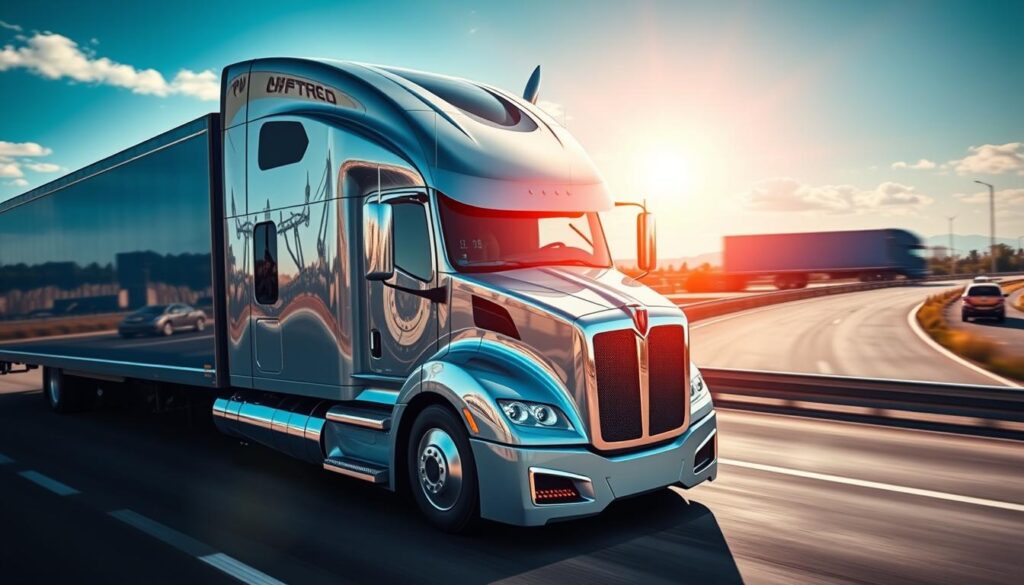
Readers will see three themes ahead: AI truck safety, autonomous freight collision prevention, and smart AV braking. Data-driven models learn with miles and updates, improving situational awareness in varied traffic and weather.
Iottive connects edge sensors, mobile apps, and cloud platforms to move vehicle data securely so fleet operators get real-time alerts, diagnostics, and blind-spot info. That integration delivers clear benefits for transportation fleets aiming to cut costs and save fuel.
Key Takeaways
- Perception, decision, and actuation systems reduce human-error incidents on highways.
- Data and continuous updates make systems smarter with more miles driven.
- Connected platforms offer real-time alerts and diagnostics to fleet managers.
- Smart integration can lower operational costs and improve fuel use.
- Iottive brings IoT, BLE, and cloud-mobile integration to secure fleet data flows.
Why Collision Avoidance Matters Now in U.S. Autonomous Freight
Industry pressures are colliding: fewer people, higher expenses, and tougher expectations for reliable delivery.
Drivers are in short supply—over 80,000 openings today and projections near 160,000 by 2030. That gap raises operating costs and strains dispatch and maintenance management.
Driver shortages, rising costs, and safety pressures
Human error causes about 94% of truck accidents, so reducing mistakes is the top priority. Automated systems help protect drivers and preserve delivery windows.
The present-day shift toward highway autonomy and hybrid fleets
Early deployments focus on predictable highway legs while human drivers handle urban traffic and complex road scenarios. Hybrid models cut downtime and can lower fuel use by up to 10% in continuous operation.
“Data-driven safety programs give fleet managers early warnings that reduce maintenance surprises and time off the road.”
| Metric | Typical Value | Impact |
|---|---|---|
| Driver shortfall | 80,000 now → 160,000 by 2030 | Higher hiring and retention costs |
| Human-caused incidents | 94% of accidents | Prioritizes automated mitigation |
| Tech stack cost | > $100,000 per vehicle | Offset by uptime, fewer repairs, less fuel |
Iottive supports automotive and logistics teams with connected solutions and fleet-ready integrations across IoT/AIoT to reduce incident risks and streamline operations. Contact www.iottive.com | sales@iottive.com.
Inside the Safety Stack: Sensors, Perception, and Control That Prevent Collisions
Layered sensing and rapid decision loops give vehicles the best chance to avoid unexpected road events.
LiDAR, radar, and high-resolution cameras create overlapping fields of view. LiDAR provides depth and range. Radar measures object speed and works in poor visibility. Cameras add visual detail for signs and markings.

Sensor fusion and computer vision for lane, sign, and obstacle detection
Sensor fusion merges real-time data into a single scene. Algorithms and models then track lane boundaries and classify obstacles. This reduces false positives and improves lane keeping when road markings fade.
Real-time decision models for speed, lane keeping, and evasive maneuvers
Artificial intelligence and machine learning power perception and decision layers. Models translate inputs into precise control outputs for speed and steering. Edge compute handles millisecond tasks while the cloud delivers continuous learning and updates.
Automated braking and stability control for emergency responses
Predictive models prime automated stability control and emergency stops before events escalate. Robust systems engineering adds redundancy—multiple sensors, fail-operational compute, and health checks—to maximize performance.
- Redundant sensors ensure coverage across long range and short range detections.
- Telemetry supports proactive maintenance by surfacing anomalies early.
- Clear interfaces keep drivers informed about system status and features.
“Waymo’s latest generation pairs long- and mid-range LiDAR with high-resolution cameras and radar to extend perception in low visibility.”
Iottive connects vehicle sensors to edge gateways and cloud platforms to enable low-latency safety signals and over-the-air updates across fleets. www.iottive.com | sales@iottive.com.
AI truck safety: From early warning to proactive risk management
When vehicles stream context-rich data, managers can turn near-misses into teachable moments.
Continuous monitoring links driver state, vehicle dynamics, and road conditions so teams spot risks early. In-cab camera feeds and wearable BLE signals flag distraction, fatigue, and aggressive maneuvers. Telematics surface performance anomalies and hazardous route segments.
Monitoring driver states, vehicle dynamics, and road conditions
Real-time metrics let management act before small issues become big accidents. Machine learning mines patterns in near-misses and recommends targeted coaching and operational adjustments.
Video analytics to reduce risky behaviors and improve training
Algorithms analyze in-cab video to detect tailgating, lane distractions, and signs of fatigue. Alerts prompt timely breaks and coaching that improve driver behavior without adding workload.
- Prioritization: Models link severity, context, and frequency so teams fix the highest-impact issues first.
- Closed loop: Vehicles feed unified dashboards to measure training outcomes and track trends over time.
- Privacy and governance: Configurable controls protect personal data while preserving evidence for investigations.
Iottive builds end-to-end IoT/AIoT stacks that bridge BLE wearables, mobile apps, and cloud analytics to deliver real-time coaching, incident flags, and training loops for fleets. www.iottive.com | sales@iottive.com.
Autonomous freight collision prevention in action
Real-world runs show how long highway stretches favor steady perception and control, while city blocks expose systems to fast-changing risks.
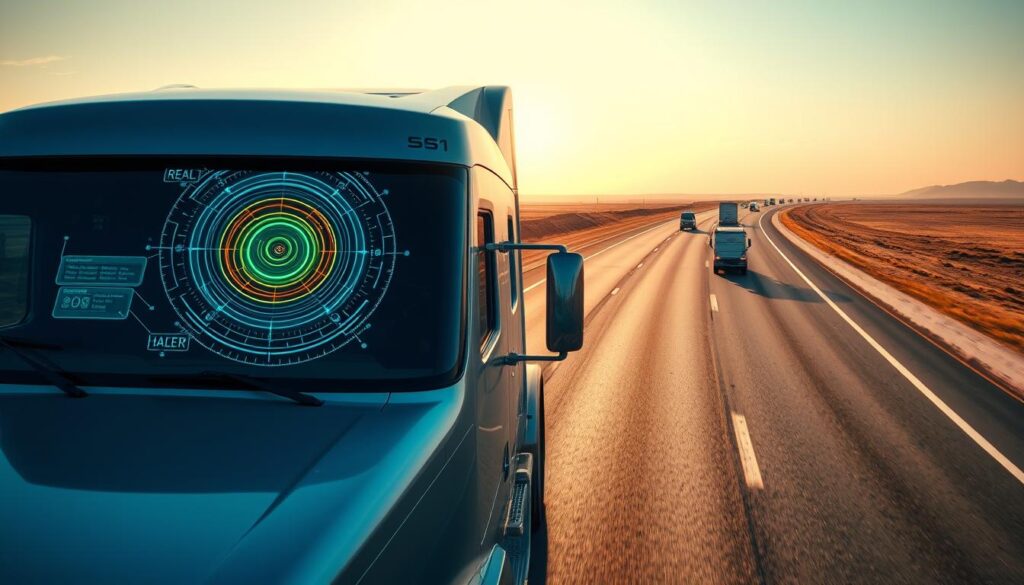
Highway piloting today versus complex urban driving
Highway routes offer wide lanes, predictable traffic, and steady speed. Cameras, radar, and other sensors keep a clear picture of the road and nearby vehicles.
Urban driving brings pedestrians, cyclists, and frequent signals. Those mixed interactions create the biggest challenges and keep many operations human-led for now.
Human override, fallback strategies, and safe-stop protocols
Human override gives immediate control when systems face unknown situations. Fallback procedures let the vehicle perform a controlled stop if confidence drops.
Real-time data on weather and road conditions helps dispatch reroute runs and reduce accidents. Mid-route maintenance alerts can trigger planned stops to avoid larger failures.
| Scenario | Typical Response | Benefit |
|---|---|---|
| Open highway | Steady lane keeping and adaptive speed | Improved uptime and fuel use |
| Urban intersection | Human-in-loop control or slow hold | Reduced risk with complex users |
| Sensor fault / low confidence | Safe-stop to roadside or shoulder | Clear, verifiable recovery |
“Iottive integrates roadside and in-vehicle IoT sensors with cloud backends to share condition data to vehicles and dispatch, improving route choices and safe-stop decisioning.”
www.iottive.com | sales@iottive.com
Smart AV braking and adaptive control under real-world conditions
Modern control systems tune stopping power to match real-world loads and road surfaces. Adaptive setups keep stopping distances consistent at speed and help preserve components across long runs.
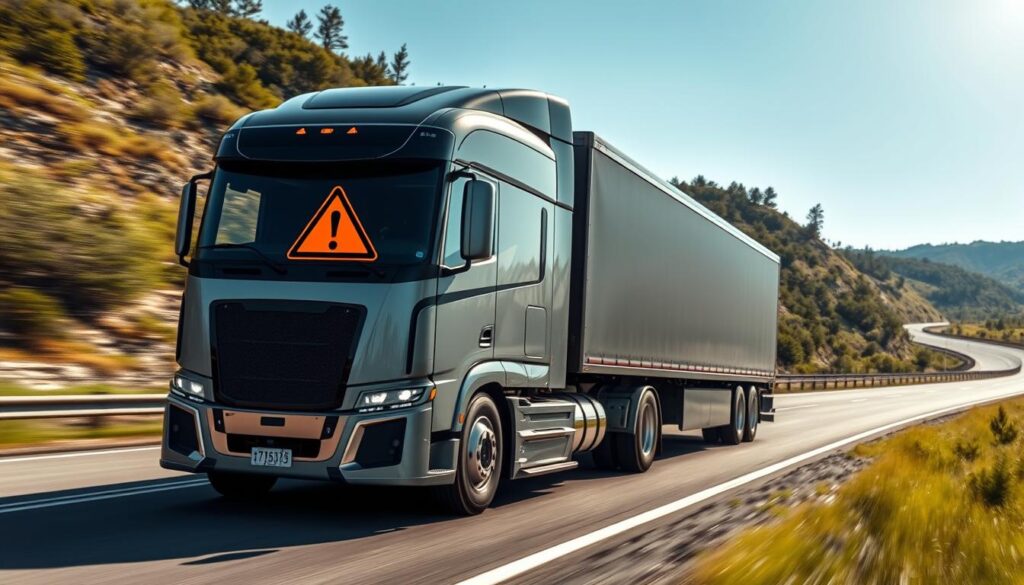
Performance in adverse weather, traffic patterns, and variable loads
Systems adjust braking and traction when road conditions change, factoring in weather, lane grade, and cargo shifts. This keeps the vehicle stable and reduces abrupt maneuvers in mixed traffic.
Coordinated engine braking, service brakes, and traction control cut skid risk in wet or low-friction conditions. Smoother inputs via predictive control also improve fuel efficiency and extend brake life.
Continuous sensor feedback tracks tire grip, load shifts, and gradients. That data drives low-latency commands and proactive maintenance alerts so teams can address brake fade or sensor degradation early.
- Efficiency gains: smoother speed control and predictive tuning can reduce fuel use by up to 10%.
- Operational benefits: over-the-air updates refine calibrations without downtime, keeping performance high across seasons and routes.
“Fielded systems on U.S. corridors show reliable operation despite changing weather and traffic patterns.”
Iottive’s edge-to-cloud integrations support low-latency signals, load-aware tuning, and OTA updates so fleets maintain peak performance and efficiency. www.iottive.com | sales@iottive.com.
Data, Cloud, and Fleet Management: The Backbone of Safe, Efficient Operations
A reliable data backbone makes split-second control and long-term planning possible for operators.
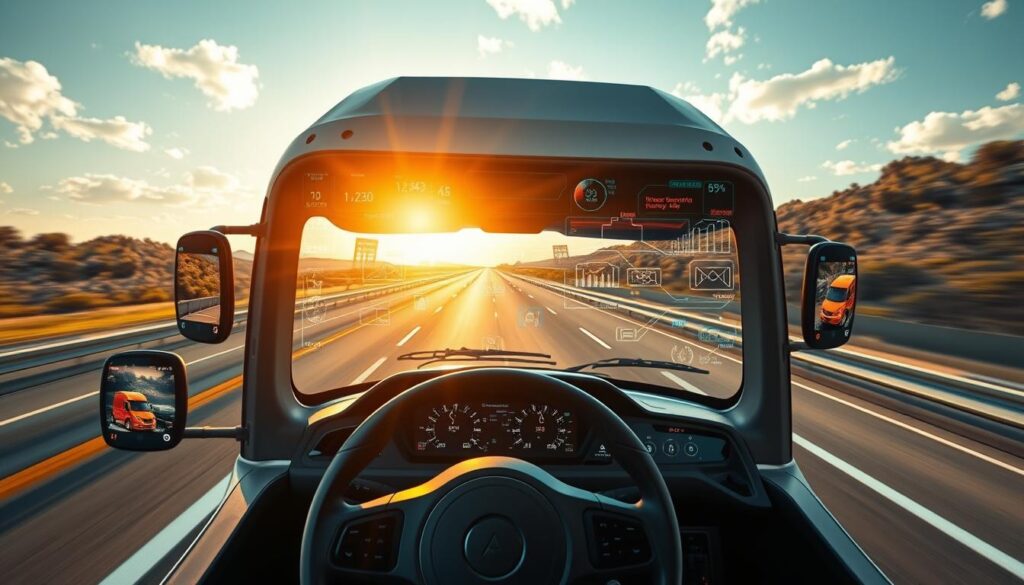
Edge compute handles millisecond decisions so safety-critical systems react instantly. Cloud platforms then push updated models, maps, and routing intelligence to each vehicle.
Predictive maintenance uses sensor feeds and telemetry to forecast failures and schedule service. That reduces unplanned downtime, lowers costs, and keeps vehicles on the road.
Route, maintenance, and cybersecurity
Route optimization balances delivery windows, traffic, and road constraints to cut empty miles and improve fuel efficiency.
Standardized schemas and APIs connect dispatch, maintenance, and analytics so teams share one source of truth.
- Real-time data for reroutes during incidents and weather.
- Dashboards that unify KPIs across maintenance, fuel, and on-time performance.
- Cybersecurity by design: encrypted OTA updates, strong identity, and continuous monitoring.
“Algorithms learn from fleet-scale patterns, improving planning and intervention timing as journeys feed back into the loop.”
Iottive delivers edge-to-cloud pipelines, BLE app development, cloud & mobile integration, and secure OTA mechanisms to operationalize safer, more efficient fleet management. www.iottive.com | sales@iottive.com.
Who’s Driving the Future: Leading Players, Deployment Paths, and the Road to Full Autonomy
Leading platforms show how varied strategies can converge on safer, more reliable long-range vehicle operation.
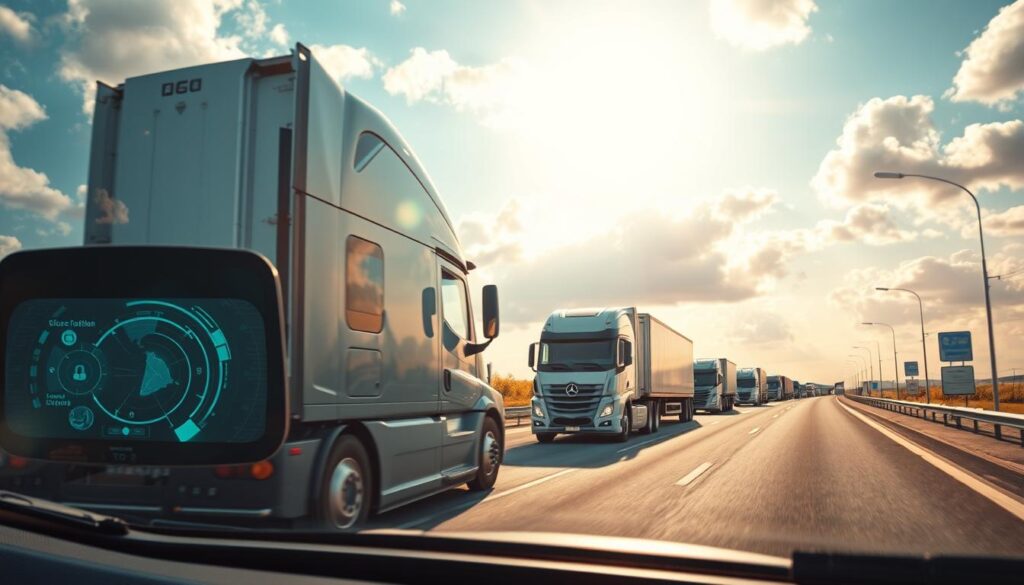
Waymo, Tesla, TuSimple, Embark, and Aurora: different strategies, common goals
Waymo Via runs Class 8 pilots across TX, AZ, NM, and CA with long- and mid-range LiDAR, high-res cameras, radar, and thermal sensing to extend detection distance.
Tesla offers lane keeping, adaptive cruise, and jackknife mitigation in its Semi. TuSimple showcased an 80-mile run without a human onboard. Embark focuses on Level 4 retrofits, and Aurora links vehicle systems with logistics networks.
Levels of automation today and integration with infrastructure tomorrow
Autonomy spans Levels 1–5 today, with most commercial pilots in the Level 2–4 band. Future roads will include connected hubs, automated docks, and route-aware infrastructure that let vehicles make more decisions without human input.
| Company | Primary focus | Deployment note |
|---|---|---|
| Waymo Via | Long-range perception | Class 8 pilots in multiple states; LiDAR to 1 km, radar >500 m |
| Tesla | Production features | Semi with lane keeping and adaptive cruise; in-service fleets |
| TuSimple | End-to-end autonomy | Completed long-distance driverless trip; highway focus |
| Embark / Aurora | Retrofits & logistics | Level 4 kits and logistics integrations for yard and hub workflows |
Companies balance speed, reliability, and public trust by validating features and sharing limits. Radar and long-range perception stacks reduce accidents by increasing detection range and confidence.
“Investment in interoperable technology builds momentum toward future autonomy without sacrificing accountability.”
Iottive partners with automotive innovators to connect sensors, mobile apps, and cloud platforms, accelerating pilots and deployments with secure IoT/AIoT foundations. www.iottive.com | sales@iottive.com.
Conclusion
The road ahead blends technology, human judgment, and clear rules, guiding fleets toward lower incidents and better performance.
Safety remains the north star: layered systems cut accidents and collision risk while supporting drivers in real traffic. Measurable efficiency gains follow—better routes, fewer delays, and less fuel use as learning models improve with fleet data.
Teams must pair rigorous maintenance, secure connectivity, and clear governance to handle weather and traffic variability. Success balances technology with people: training, change management, and transparent validation build trust across the industry.
Explore pilot programs and connected operations with Iottive. We help design, integrate, and scale end-to-end IoT/AIoT solutions that make vehicles safer and more efficient from day one. Visit www.iottive.com or write to sales@iottive.com.
FAQ
What is the role of advanced collision‑avoidance systems in the future of long‑haul trucking?
These systems combine sensors, perception software, and control logic to detect hazards early and apply corrective actions. They help fleets cut crashes, lower insurance costs, and boost on‑time deliveries. By processing camera, radar, and LiDAR inputs, vehicles can slow, steer, or warn a human operator in milliseconds to reduce risk.
Why does improved crash prevention matter for U.S. commercial carriers now?
Carriers face driver shortages, rising operating expenses, and stricter regulations. Better preventative tech reduces liability, helps retain drivers, and improves uptime. Highway automation also supports longer, safer runs and complements hybrid operations that still rely on human oversight in complex settings.
How do LiDAR, radar, and high‑resolution cameras work together?
Each sensor has strengths: radar senses speed and distance in poor weather, LiDAR maps precise 3D shapes, and cameras read signs and lane markings. Fusing these views creates a robust understanding of the scene so control systems can make accurate, timely maneuvers under varied conditions.
What is sensor fusion and why is it important for perception?
Sensor fusion merges data from multiple devices to reduce false alarms and fill gaps when one sensor is limited. Combined with computer vision, it improves lane detection, object classification, and the ability to track pedestrians, cyclists, and slow vehicles on mixed highways and urban streets.
How do real‑time decision models manage speed and lane keeping?
Models run on edge processors to evaluate trajectories, predict other road users’ paths, and pick safe actions. They balance route progress with risk, deciding when to slow, change lanes, or signal for human intervention. These millisecond responses are crucial for preventing cascading incidents.
What emergency responses do automated systems provide?
Systems include active deceleration, emergency steering assists, and stability control to keep rigs upright under sudden load shifts. They prioritize occupant protection and minimal roadway disruption while engaging alerts that notify nearby vehicles and fleet operators.
How can onboard monitoring reduce risky driver behavior?
Video analytics and telematics track fatigue signs, distracted steering, and harsh maneuvers. Fleets use this data for coaching, targeted training, and incentive programs. The aim is proactive risk management that improves human performance alongside automated aids.
What’s the difference between highway piloting and urban driving for heavy vehicles?
Highway piloting relies on predictable lanes and steady speeds, making sensor coverage and adaptive cruise easier to apply. Urban environments demand rapid detection of pedestrians, cyclists, and complex intersections, where fallback strategies and human takeover options become more frequent.
How do human override and safe‑stop protocols work?
Systems provide graduated alerts before handing control back to a human. If the operator cannot or will not respond, safe‑stop routines decelerate to a controlled stop in a low‑risk location while notifying fleet managers and emergency services as needed.
How do these systems perform in bad weather or with heavy payloads?
Performance varies: rain, snow, and glare can reduce camera and LiDAR effectiveness, while radar remains more resilient. Control algorithms account for load shifts and braking distances, adjusting following gaps and speed limits to maintain stability and stopping ability.
Why is edge computing critical for fast responses?
Edge compute keeps sensing and decision making on the vehicle, eliminating network latency for urgent events. The cloud still plays a key role for model updates, large‑scale analytics, and fleet coordination, but split processing ensures safety when milliseconds matter.
How do fleets use data to improve routing, maintenance, and fuel use?
Telematics and machine learning analyze driver habits, traffic patterns, and component wear to optimize routes, schedule preventive service, and reduce idling. These gains lower fuel consumption and extend vehicle life while improving predictability for shippers.
What cybersecurity measures protect connected vehicles and over‑the‑air updates?
Modern platforms use encryption, secure boot, and authenticated update channels to prevent tampering. Network segmentation and intrusion detection keep operational systems isolated from infotainment and external links, protecting control modules and fleet data.
Which companies are leading deployment and how do their approaches differ?
Waymo focuses on perception and fully driverless services, Tesla emphasizes camera‑forward systems and fleet learning, TuSimple and Embark prioritize freight corridors and operational scaling, while Aurora integrates sensors with OEM partnerships. Each blends hardware, software, and testing strategies to reach safe, scalable solutions.
What levels of automation are in use today and what comes next?
Most commercial operations use driver‑assist and conditional automation for highway segments, with humans supervising. The next steps expand driverless capability in controlled corridors, tighter integration with intelligent infrastructure, and broader urban validation toward higher automation levels.
Transform Your IoT Vision Into Reality.
Get free expert insights, architectures & cost breakdowns.
Drop your email to schedule free meeting.